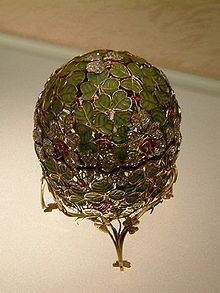Year delivered 1902 | Customer Alexandra Fyodorovna | |
 | ||
Height 9.8 centimetres (3.9 in) Similar Standart Yacht, Memory of Azov Egg, Alexander Palace, Moscow Kremlin, Bay Tree | ||
The Clover Leaf Egg is a jewelled Easter egg made under the supervision of the Russian jeweller Peter Carl Fabergé in 1902 for Tsar Nicholas II of Russia. It was presented by Nicolas II as an Easter gift to his wife, the Tsarina Alexandra Fyodorovna. It is currently held in the Kremlin Armoury Museum in Moscow, and it is one of the few Fabergé eggs that have never left Russia.
Contents
Design
The Clover Leaf Egg is made of an openwork pattern of stems and leaves of clover forming the shape of an egg. The gaps between the metal outline of the leaves are covered with transparent bright green enamel. A very thin golden ribbon paved with rubies curls through the foliage. At the time, the production of transparent enamel was still a new method, and often suffered from problems while cooling. There are no flaws in the enamel of the Clover Leaf Egg, but it is considered too fragile to travel.
Surprise
The surprise in the egg has been lost but according to archives it is reported to be a four leaf clover with twenty three diamonds, and four miniature portraits of the four daughters of the Tsar: Olga, Tatiana, Maria, and Anastasia.
